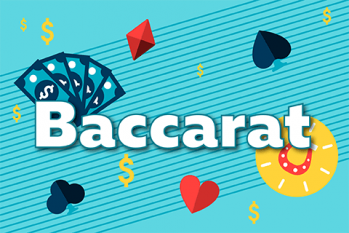The objective of the game is that both dealer and player are dealt two cards. In some cases, an additional third card is needed to determine the outcome of the game. The hand that is closer to 9, wins, and winnings are paid on corresponding bets. The purpose of the game is to bet on a winning outcome.
The third card, if needed, is dealt according to third card rules. These rules are compulsory and therefore automatically applied by the dealers. There is no need for a player to learn them. For curious players, the third card rules are available on the internet and are easy to understand.
For example, you place a 10 dollars on the player. Cards are dealt. Banker receives a 7 and an ace for a hand value of 8. The player receives a 9 and a king, for a hand value of 9. The player's hand value is higher and wins. You get paid one to one for the bet.
Another example, you place ten dollar bet on a tie. The cards are dealt. Banker receives a 10 and an 8, for a hand value of 8. The player receives a 3 and a 5, for a hand value of 8. Both hand values are equal. The tie bet wins and gets paid 9:1, which equals 90 dollars plus the original bet is returned.
Some examples of the third card rule. If the hand player has a value from zero to five he draws a third card. If the player hand has a value of 6 or 7, he stands. If the player has a hand value of 8 or 9, that’s called a “natural” and both hands stand. After the player’s hand receives a third card, the banker's hand receives a third card according to the following rules: if the banker has a hand value from zero to two, he draws a third card.
If the banker has a hand value of three to six, he draws a third card or stands, depending on the player’s third card value. If the banker has a hand value of seven, he stands. If the banker has a hand value of eight or nine, that’s called a natural and both hands stand. There is no need to know these rules in order to play.
Here are some examples of third card rules applied. A ten dollar bet is placed on the player. Cards are dealt. Banker receives a 10 and a 4 for a hand value of 4. Player receives a 5 and a 2 for a hand value of 7. Player stands because of his hand value. A third card is dealt automatically to the banker because of his hand value. Banker receives a 3 for a total hand value of 7. It’s a tie. Bets on a player or banker are lost.
Next example. A hundred dollar bet is placed on the banker. Cards are dealt. Banker receives a queen and a 3 for a hand value of 3. Player receives a 4 and a 10 for a hand value of 4. Player automatically draws a third card because his hand value is between 0 and 5. Player receives an ace for a total hand value of 5. Now according to specific complex third card rules, banker draws a card and receives a 3.
Total hand value is 6. Banker’s hand wins. You get paid one to one, with the casino keeping a 5% commission (?) on the bankers bet, so the winning amount is 95 dollars with the original 100 dollars. The value of a single bet starts relatively high at a minimum of around 25 dollars and goes up to 500. The common maximum is somewhere at 10 000 dollars.
The player who has the highest bet on the "Punto" hand is given the "Punto" cards, though he or she simply turns the cards over, announcing their total. The croupier instructs the "banker" when to deal third cards, and then announces the winning hand.


 The most popular one provided by most casinos being Punto Banco which is played at an oval table similar to the other variation, the aforementioned French Chemin de Fer, where the shoe is also passed around the table by the players who are acting as the dealers and as bankers. The players aren’t actually banking the game and the role of the banker is merely ceremonial.
The most popular one provided by most casinos being Punto Banco which is played at an oval table similar to the other variation, the aforementioned French Chemin de Fer, where the shoe is also passed around the table by the players who are acting as the dealers and as bankers. The players aren’t actually banking the game and the role of the banker is merely ceremonial.